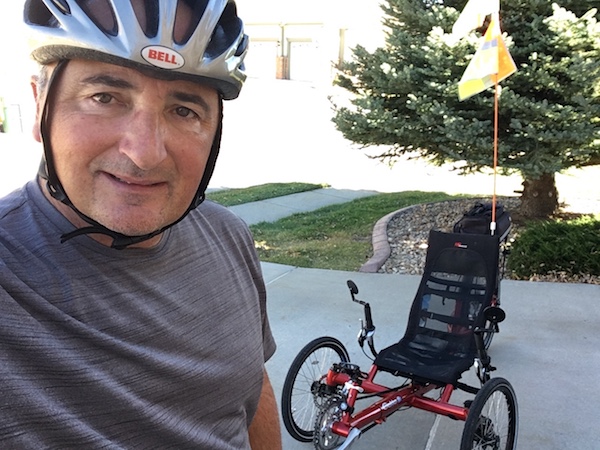After one of our monthly YOPD Council webinars about exercise and Parkinson’s, a member of our community asked us a question about cycling. We decided to reach out to Davis Phinney Foundation Ambassador Tom Palizzi, who passed along such valuable advice that we wanted to share it with all of you.
“I’d love to be able to get advice on biking recommendations for someone whose balance is too iffy for safe outdoor biking and who has limited indoor room for a fancy stationary bike.”
Tom’s answer: “Your situation is quite common among people living with Parkinson’s. I faced these same issues and am happy to share my opinion and recommendations.
For cycling outdoors, the impact of Parkinson’s symptoms can result in a variety of issues — balance, as you mention. Other problems might arise from slowness, rigidity, and cognition. Having been an avid cyclist my entire life, PD brought on anxiety and a struggle with confidence. Cycling became more of a stressful thing than pleasurable. Could I clip-out fast enough, shifting and stopping — and then this issues with balance.
I bought a trike a few years ago. Not on a whim by any means but following a pretty exhaustive study. Plain and simple — the best decision for me! I have a tadpole style, HP Velotecnik Gekko 26. It’s fast, comfortable, safe, and easy to ride, plus it folds in half for transport and storage. Comparably priced with a good mid-range road bike it weighs around 30 lbs.
For an indoor stationary bike, there are essentially three options: a traditional bike on a trainer stand; a sophisticated, computerized in-home fitness machine; and a plethora of bikes in between. I’m a proponent for the in-between solutions. There are many to choose from. On the high-end, Peloton, Echelon, and NordicTrack bikes are quite costly and may present a storage problem. But what most people don’t realize is that technology tends to leave products behind, prices go down, and thus, the Peloton of today becomes obsolete in a short amount of time.
On the other end of the spectrum, the seemingly lower cost bike-on-a-trainer solution can end up costing you dearly. When mounted on a trainer, they tend to stand much higher than normal, creating a challenge in getting on and off. They are also much less stable since they lack the weight and lower center of gravity. I strongly encourage people — especially PD folks — to find a bike more suitable.
Studio or home exercise bikes built for stationary cycling are your best bet. Ranging in price from the lower hundreds to $1,000 or so, they are much safer, easier to get on and off, and won’t break your bank. They can also be much easier to store! I ride an older LeMond Studio bike with no frills. I use a heart rate monitor and a cadence monitor — the only things you really need. I have a tray on the handlebars to hold my iPad from which I run a Pedaling For Parkinson’s class three times a week — a five-year-old set-up.
Keep it simple. Keep it safe.”

We also received this advice from reader Pete Huley: “An alternative solution is a folding bike like the Brompton, which has two wheels instead of three. I chose the Brompton a little more than a year ago when I was worried about issues like balance, safety, and space/portability. Its smaller configuration with 16-inch wheels and a step-through frame offered an alternative to my standard road bike while preserving a standard bike feel. Indoors, I use a standard Cannondale hooked to a Cycleops ‘dumb’ trainer. I put a step platform next to the bike to help with mounting, and with this setup I’m able to successfully and safely participate (‘suffer’) in Sufferfest cycling.”
Want to learn more about how cycling helps you live well with Parkinson’s?
What You Need to Know about Cycling with Parkinson’s
Everything You Ever Wanted to Know about Ebikes for People with Parkinson’s…And More
Exercise Is Medicine for the Brain
How to Exercise with Parkinson’s
Want to Join us for our monthly YOPD Council sessions?
Learn more and register for free here. They happen on the third Thursday of every month at 12 pm PDT. If you can’t make it at that time, register anyway and we’ll send you the recording as soon as it’s ready.

















